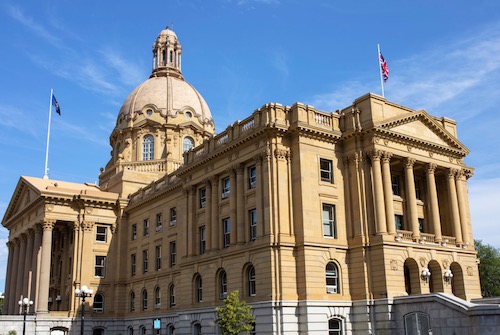This morning, Premier Kenney and Associate Minister of Natural Gas and Electricity Dale Nally revealed Alberta’s Hydrogen Roadmap at a news conference, following on the province’s Recovery Plan and Natural Gas Vision and Strategy (both of which articulated an ambition to incorporate hydrogen into Alberta’s energy portfolio) and the federal government’s “Hydrogen Strategy for Canada”, all released in 2020.
The Vision
The Hydrogen Roadmap is a 50-page document, self-described as “the path forward for Alberta to remain competitive in the global clean energy economy by leveraging our existing strengths and expertise.” The document underlines the potential scale of the economic opportunity, Alberta’s competitive positioning as a future global supplier of clean hydrogen and points to two key impetuses for grasping the opportunity:
- Unlocking economic value for the province and capturing a growing export opportunity, including:
- Attracting over $30 billion in new capital investment in clean hydrogen production and development,
- creating 0.7 bcf of new natural gas demand in Alberta through hydrogen production by 2030,
- targeting 10 million tonnes of clean hydrogen export by 2050, and
- creating tens of thousands of jobs during project construction phases, with thousands for operations.
- Advancing critical environmental outcomes, particularly by integrating hydrogen into
Alberta’s existing energy system and using hydrogen to displace carbon-based fuels in:- industrial processes,
- commercial and residential heating,
- transportation, and
- power generation.
Plans for Action
To reach a 2030 ambition for integrating hydrogen into these processes and to establish Alberta as “the global supplier-of-choice in clean hydrogen exports”, the province has laid out seven policy pillars:
Policy Pillar | Approach | Notable policy actions (full lists |
1. | Build out supply and commercialization pathways, like hydrogen blending in |
|
2. | Ensure the infrastructure is widely available for large-scale clean hydrogen production |
|
3. | Long-term investment certainty and funding, to overcome hydrogen’s challenging economics |
|
4. | Demonstration |
|
5. | Bring the full hydrogen value chain into the regulatory regime for safety codes and standards |
|
6. | Public-private |
|
7. | Establishing |
|
Production Pathways: Blue, green, or all of the above?
The Roadmap is officially agnostic on the production pathway for hydrogen. As Minister Nally said in the press conference, the government is “agnostic over the colour of the hydrogen, as long as it is clean and industry will decide what type of production it will be.” In fact, the roadmap does not use the shorthand terms “blue” (typically used to refer to blue hydrogen produced from oil and gas by steam methane reformation (SMR), with carbon capture and sequestration) or “green” (produced by electrolyzing water with renewable electricity) at all, but consistently refers to Alberta’s production of “clean hydrogen”.
The Roadmap pays some attention to renewable-based production of hydrogen by electrolysis and notes that “wind-powered hydrogen production via electrolysis” produces the hydrogen with the lowest lifecycle GHG emissions. Minister Nally was clear that Alberta intends to “encourage all forms of clean energy production, including hydrogen made from renewable energy and water.” Indeed, it points to the opportunity to use hydrogen as storage for intermittent renewables, pointing particularly to Alberta’s wind energy resource.
However, the Roadmap places substantial emphasis on SMR and autothermal reforming (ATR) and focuses on applying CCUS to these natural-gas-based processes for clean hydrogen production. It notes that hydrogen from renewable energy is a medium- to long-term opportunity, as the technology is not currently cost competitive. It also points to analysis the department commissioned from the University of Alberta to conclude that SMR and ATR production (with or without CCS) is cost-competitive with global competitors, whereas wind-based electrolysis is more expensive in Alberta than elsewhere. In other words, the Roadmap concludes that Alberta has a competitive advantage with blue hydrogen specifically. While no policy pillar pushes hydrogen from renewable energy specifically, there is a clear policy pillar to support blue hydrogen with CCUS infrastructure.
Furthermore, the Roadmap points to Canada’s Hydrogen Strategy for the proposition that electrolytic hydrogen based on Alberta’s existing grid would be higher than lifecycle emissions from SMR with CCUS. Unfortunately, this assertion does not take account of the rapid decarbonization underway in Alberta’s electricity grid, nor the opportunity to link electrolysis specifically to renewable electricity, though this opportunity is acknowledged elsewhere in the Roadmap.
Climate action and carbon standards for clean hydrogen
The Roadmap estimates that large-scale integration of hydrogen into Alberta’s energy systems could reduce GHG emissions by 14 million tonnes (Mt) per year in 2030 – approximately 5% of Alberta’s current emissions. It notes that GHG reduction will accelerate from there out to 2050.
The Roadmap openly acknowledges the carbon intensity thresholds being developed
by potential export markets, such as Europe’s CertifHy project. With a 4.37 kg CO2 / kg H2 standard, the Roadmap acknowledges that SMR with 85% CCUS capture rate does not achieve this standard. The province commits to collaborating with other governments and international partners to support “the development of science-based carbon intensity thresholds for hydrogen production.”
Related Links
- Government of Alberta’s News Release: “Alberta on the path to a bright hydrogen future”
- Alberta’s Hydrogen Roadmap
- Government of Canada’s Hydrogen Strategy





